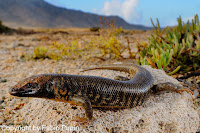New reptile discovered in Socotra
In the Soqotra Archipelago, a new reptile has been discovered. The Archipelago already has some of the rarest animals on Earth. Geckos are the most represented reptiles in the island: 6 species belong to the Semaphore geckos (genus Pristurus), 6 to the genus Hemidactylus and 2 to the endemic genus Haemodracon; but there are also other lizards, snakes and a chameleon. Reptiles are every where on the islands; as very few people ever visit this jewel of the Middle East, very few photos exist of reptiles or of animals or of other life forms, of the Archipelago. From Mongabay:
+ Very rare photos of Socotra's Wildlife: Fabio Pupin
"Over one third of Socotra's plants are found no-where else on Earth, i.e. endemic, while 90 percent of its reptiles are also endemic. Adding to its list of unique life-forms, researchers have recently uncovered a new skink species that is found only on the island of Abd al Kuri, which is slightly smaller than New York City's Staten Island."
"Describing the new species in a paper in Zoological Scripta, the team of researchers named it Christine's mabuya (Trachylepis cristinae), after its discoverer. With the discovery of the new skink, the small island of Abd al Kuri is now home to five reptiles found no-where else on Earth."
"As probably happened quite often in other parts of the world, skinks may have reached the archipelago by rafting on logs or other floating vegetation. Reptiles such as skinks and geckos have proved to be incredibly good dispersers, and they are even known to have crossed the Atlantic ocean."
".......the most surprising thing about the Socotra Archipelago is that it has not been swept by extinctions like so many other of world's islands. To date, scientists believe the islands have lost none of their endemic birds, reptiles, or mollusks in the last century; compare that to the Hawaiian Islands which has lost nearly one-third of its endemic birds. Still, even though the Socotra Archipelago is largely protected and are not unused to humans (a population of around 50,000 has lived on the archipelago, mostly Socotra Island, for thousands of years), researchers fear that the Socotra Archipelago could soon begin to see its biodiversity vanish if the region is mismanaged."Without doubt, there are still many more discoveries and many more amazing secrets to be discovered about Socotra. With Yemen's continuing political instability; with continuing conflict in Somalia; with the waters around the Archipelago swarming with pirates and those fighting them; and with the continuing influx of tourists to the Archipelago, Socotra's extraordinary wildlife may not have long to be secure.
+ Very rare photos of Socotra's Wildlife: Fabio Pupin


